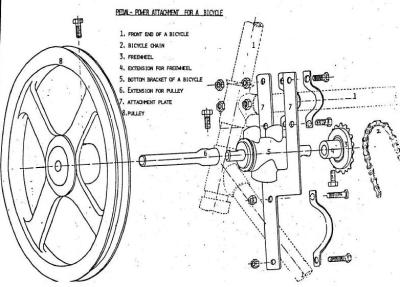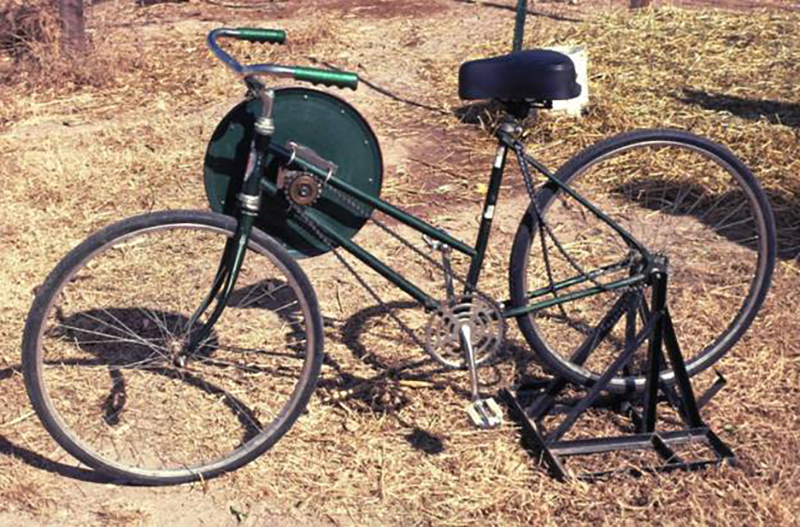It’s hard to argue that bicycles aren’t super handy. They get you from point A to B in a jiffy with little effort. Since these machines are so simple and convenient, why not use them for things other than transportation? Well, [Job] set out to do just that.
[Job’s] starts with a standard single speed bike and adds a few parts. First, a stand is installed to the back axle. When in the down position, it lifts the rear wheel off of the ground and provides support so the bike does not tip over. When flipped up into the ‘up’ position the stand creates a rack for holding goods and the bike can be pedaled around in a normal manner.
 Next, a jack shaft made from a bike bottom bracket and crank is installed up front in between the top tube and down tube of the frame. On one side of the jack shaft is a sprocket and the other side is a large pulley. When converting to what [Job] calls ‘power production mode’, the chain going to the rear wheel is removed from the crank sprocket and replaced with a chain connected to the jack shaft.
Next, a jack shaft made from a bike bottom bracket and crank is installed up front in between the top tube and down tube of the frame. On one side of the jack shaft is a sprocket and the other side is a large pulley. When converting to what [Job] calls ‘power production mode’, the chain going to the rear wheel is removed from the crank sprocket and replaced with a chain connected to the jack shaft.
With the rear stand down supporting the bike and the pedals now powering the jack shaft and large pulley, it is time to connect the bike to any sort of machine. A belt is slung around the pulley and connected to a matching pulley on a power-hungry machine. This dual-purpose bike has powered a rice thresher, peanut sheller, water pump, table saw and even a wood lathe!
[Job] set out to create a simple and inexpensive way to make a bike even more useful than just riding around town. We think he did just that. For more bike-powered stuff, check out this generator.
















Its hard to argue they ARE super handy or hard to argue they ARENT? I think you accidentally a word there. Yay I get to be that guy for once. I think this article will be a good one though. No one grumbling about arduino or not hack blah blah blah.
Hmmm… I think you’re right. Fixed.
> I think you accidentally a word there.
The guy who misses a word in the above sentence? :-)
http://knowyourmeme.com/memes/i-accidentally
It’s a thing on the internet
That’s a thing people say now, aren’t you hip to the jive?
Nope. :-)
Alright! Now connect the bike to my chainsaw and drag it into the woods and up the hill to clear ground and make some firewood ;-)
Well, you could use a flexible driveshaft for some amount of reach, or a develop a pneumatic tool and an air pump for the purpose.
I keep thinking about driving a big, heavy flywheel, so that whatever power-consumer can continue running while switching riders. Only problem is towing around the flywheel. ;D
flexible connections are too inefficient for human powered machines.
https://www.youtube.com/watch?v=WXvvN5BmX8c
I built this pedal system for a local festival. The motor was loaned by another guy and with eight people pedalling, it took about 20 minutes to boil a kettle of water. That about 4 times as slow as an electric kettle so about 400 watts. This matched up nicely to my estimate of between 50 and 100 watts per person over any useful time period. Tour de France racers might average 300 watts for the all day racing and 400 watts to climb mountains. Average people are just not strong enough to match petroleum or the electrical grid.
Nice. I like the simplicity of it. Could be useful in some situations.
The energy to drive this obviously comes from the calories in the food you eat. What do you suppose the cost of that energy is? Betcha it’s several dollars per kilowatt hour (or horsepower hour if you prefer). You also certainly will use more energy in the shower you’ll need after using this than you produce with it.
> You also certainly will use more energy in the shower you’ll need after using this than you produce with it.
That would be an impressive feat considering it’s intended for use in locations that do not have ANY power.
Well, you got to have hot water somehow.
The human metabolism and mechanical efficiency is between 23-25% so we would be fairly okay in comparison to e.g. a diesel engine. Both could even run on the same canola oil, to some extent.
A Bacon Cheddar McChicken costs $2 and has 2 MJ which is half a kilowatt-hour. Accounting for efficiency, eating at McD costs you $14.50 per kWh.
Plain cooked rice costs $409.50 per ton, and contains 5.4 MJ/kg so in the same way, it costs about a dollar per kWh.
Of course,it takes nearly 2 MJ to cook a kilo of rice in a rice cooker, and 3-6 MJ on a propane stove.
Interestingly enough, if you were to drink tax-free industrial ethanol, you’d get about 86 MJ for $1.64 or approximately 28 cents per kWh
So that’s why Mister Tally Man worked all night on a drink of rum.
But how many MJ of energy to distill 1 gallon of ethanol?
The EROI of corn ethanol is roughly 1.27 and cellulosic ethanol is about 4. Sugar cane ethanol is around 10.
So anywhere from 10-78% of the energy, depending on source.
How many times do you think they will hit your knee while generating power?
sorry, their knee not your knee :)
Heck, pedal hard enough and you might be able to run the air conditioner…
http://img270.imageshack.us/img270/3204/ebike9hp.jpg
http://static.guim.co.uk/sys-images/Guardian/Pix/pictures/2012/8/15/1345041044408/Soylent-Green-Charlton-He-010.jpg
ELECTRICITY GENERATION IS PEOPLE!!
Machines have truly become the master!
From what I remember trying out this way of generating electricity (was part of a pop-sci demonstration), making even a measly 500w of electrical power takes a fair bit of effort, not sustainable for more then a few minutes :P
Also, it would make no sense to waste power in the generator and motor, the A/C compressor should be driven directly ;-)
This is good info, though the target is for poor undeveloped areas… what do you think the industrialized world would be if we were to be deprived of our access to fuel and fuel oil? It might not be applicable or as useful as the things we have access to, but in some areas, this is a huge mechanical improvement over hand cranking.
The sad irony is that poor industrialized societies have much more limited access to the internet, and therefore are less likely to see hacks like this
http://patronatosanvincenzo.it/blog/wp-content/uploads/2014/03/1478_lom60_1478_1.jpg
This is a knife-grinder bike. The main difference is that the rear whell stays connectet acting as a flywhell.
could sell leather chaps as a sideline?
http://brimages.bikeboardmedia.netdna-cdn.com/wp-content/uploads/2011/12/Rock-the-Bike-Fender-Blender-pedal-powered-bike-blender.jpg
I guess someone should ask: “Does it blend?”
But seriously, this is a cool hack. I might have built this with a friction connection from the rear tire to the pulley shaft, that would engage when the back stand is down. Then you wouldn’t have to mess with chain swapping. It would also put the pulley in the back, where you are less likely to bang your knee. And might be easier to remove when not needed…
There are probably a dozen different ways to implement this, and they would all have their own pros and cons. My guess is that this was constructed with the materials that were already on hand (as most good hacks are), and available materials can influence design.
With the pictures already posted, I suppose that one could say “Not a hack”, as it has obviously been done, in some form or another, before. But I think only the worst pendants might rant.
The version that was covered here long ago simply sat on a stand and the wheel used friction to turn the turbine.
It seems the discussions (human-generated) usually go to ineffeciency. If you need power, effeciency does not matter so mach- you do what you have to do. However, from what we have seen when these are reviewed hera nd other places, the energy converison alone makes this impractical. Storing the energy is also a source of loss, which only diminishes over time.
However, again, efficiency does not stop necessity. I could still envision third world countries forcing rooms of people to use these to power the ‘evil general’s a/c’. (Even though we know there efforts wouldbe better spent even faming substances that could derrive energy, rather than farming, consuming, transforming into personal energy, transferring it to mechanical, transferring it to electrical.)
The positives of these thread usually go toward leaving mechanical energy mechanical. As in many of the posted pictures, use the mechanical energy to say sharpen knives or blend margaritas (without electronics). I saw an old documentary of a professor who lived in the wilderness, and used an old converted auto engine, and a mule, to power every device he needed (mechanically). Saw’s, drills, grinders etc, all with a engine that might not worth making drivable.
The previous example is supposed to represednt an unmidified bike, of course the drawbacks could be friction and perhaps this modifaction gives advantageous gearing. While unmodified bike is the most practical, the cheapest possible biuld version would be the more popular chouice in third world countries (where bike frame alone would be hard to come by, I doubt they would care if it had tires, let alone a seat).
With many developing regions having little-to-no electricity as it is, they arent likely using many high output devices. Recharging batteries for the radio and phone could very well be worth a couple hours on the bike. Though, we know a days work in a developed region would buy a solar cell that would do this for several years to come….(It is expensive and tough to be poor…)
Bike used to power illegal press during World War 2 in the Netherlands
http://www.tweedewereldoorlog.nl/100voorwerpen/wp-content/uploads/2014/01/16.-Stencilmachine-met-fiets.jpg
Is there any advantage mechanically or ease of building to having the wheel up top rather than just having it be an extension of the wheel system? Also as James stated – having a fly wheel on a system like this would really help keep to keep the system really stable, especially with light fast geared equipment.
“Pedal Power” by Rodale Press, ca 1977, can still be found if you look for it
plus
http://www.lowtechmagazine.com/2011/05/pedal-powered-farms-and-factories.html
If you want to save costs just get an exercise bike off craigslist, it’s half built for you and people will give it to you for free.
@Dax – If you tried to run a human on pure canola oil the only thing they would be sitting on is the can.
Well you do need a bit of roughage in the mix, but technically it would work.
Vegetable oil and booze are the cheapest human-digestible fuels with the most energy per pound. Refined sugar is a close third, but it’s not often well available in poor places.